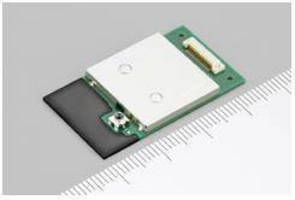WLAN Module for Smart Meters consumes 10 µA on standby.
Press Release Summary:

All-in-One WLAN Module UGFZ1 Series features built-in CPU as well as GS1011 chip with antenna, Wi-Fi protocol, and connection applications. Integrated UART physical interface, ADC, I²C, PWM, and GPIO analog/digital port allow connection with devices such as humidity and lighting sensors. Devices/systems not originally equipped for networking can be WLAN-enabled via unit's serial interface connection. Product operates for up to 10 yr on AA type lithium thionyl chloride battery.
Original Press Release:
Alps Develops Low-Power Consumption, All-in-One WLAN Module
TOKYO - Alps Electric announced today the UGFZ1 Series, an all-in-one WLAN module for wireless networks. The module's built-in CPU and networking protocol combined with low energy consumption enables easy setup of sensor or other device networks, such as those used for smart meters.
Sensor network systems promote efficient energy usage by monitoring power consumption, temperature, humidity and lighting, and using collected data to control devices. Use of these networks is expanding into areas such as communication between appliances and smart meters in homes, energy-saving management for corporations, temperature control in server rooms, security, disaster prevention and plant factories. Zigbee (*1) applications have already been launched, yet with an environment increasingly ready for WiFi (*2) infrastructure, needs are developing for easily configurable, low-cost wireless network systems.
Alps has created an all-in-one wireless LAN module to meet market needs, integrating the GainSpan-developed (USA venture corporation) compact "GS1011" chip featuring an antenna, WiFi protocol and connection applications. In addition, the module provides a UART physical interface (*3), ADC (*4), I²C (*5), PWM (*6), and GPIO analog/digital port which allow direct connection with devices such as humidity and lighting sensors. The product's internal CPU chip eliminates the need for a host CPU or development of a network stack on the set device side. These features enable easier wireless network configuration while reducing development time and design resources for sensor devices.
Due to low energy consumption and power management functions, the module is able to operate for up to 10 years (*8) on a single AA type lithium thionyl chloride battery. Furthermore, the product's serial interface connection allows wireless LAN capability to be integrated into devices and systems not originally equipped for networking. The module is suitable for medical instruments, healthcare devices such as weight scales, and real-time locating systems serving logistics and entry control management.
Finally, the UGFZ1 Series is certified for use in Japan as a stand-alone module with built-in antenna (*9). Sample shipments are to commence in May.
*1 Zigbee: A standard for short-range wireless communication. Compared to wireless LAN standards, it has a lower communication speed of 250 kbps and shorter transmission range.
*2 Name created by the WiFi (Wireless Fidelity) Alliance to promote wireless LAN standard specifications.
*3 UART (Universal Asynchronous Receiver Transmitter) is a serial communication system.
*4 ADC (Analog Digital Converter) is a circuit that converts analog signals into digital signals.
*5 I²C (Inter-Integrated Circuit) is a serial computer bus invented by Philips that is used to attach low-speed peripherals to motherboards and embedded systems, etc.
*6 PWM (Pulse Width Modulation) is a method to control electrical current and voltage by adjusting the pulse signal output time (pulse width).
*7 GPIO is a general purpose I/O (Input / Output) port.
*8 Data transmission in 10 min. intervals, using a 2000mAh battery.
*9 This device is certified that it complies with technical standards set forth under Japanese law.
Features
A low-power consumption, wireless LAN module suitable for sensor networks
1. All-in-one type with built-in antenna, wireless LAN and application processor
2. Single battery operation and low power consumption current (5µA or less on standby)
3. Autonomous operation without a host CPU is possible
4. Japan certification acquired
Principal Applications
Smart meter and home appliance communication, factory air conditioning management, environmental management in plant factories, etc.
Security sensor communication, disaster prevention management, home condition management, etc.
Health care devices, medical instruments, real-time location information systems (logistics, and entry control systems), etc.
Planned Release
Sample production From May 2010
Mass production From May 2010
Sample price 10,000 yen (tax included)
Planned monthly production 50,000 units (Planned for January 2011)
Development MMP Division, Furukawa Plant (Osaki City, Miyagi Prefecture)
Production MMP Division, Kakuda Plant (Kakuda City, Miyagi Prefecture)
Specifications
Product name UGFZ1 Series
Dimensions (W × D × H) 35.0mm × 20.0mm × 3.4mm
WLAN Compatibility IEEE 802.11b/g compatible
I/O Interface ADC, I2C, PWM, GPIO
Host Interface UART
Frequency Range 2412 to 2484 MHz
Operating Voltage +2.8V to +3.6V
Power Consumption Tx: 140mA, Standby: 5μA
Transmission Output +9.0d Bm typ.
Transmission Speed 11 Mbps max.
Security WEP / WPA / WPA2 (TKIP / AES)
About Alps Electric Co., Ltd.
Alps Electric (Tokyo: 6770) is a leading global manufacturer of high-quality electronic components for mobile devices, home electronics, vehicles and industrial equipment. With the philosophy of "Perfecting the Art of Electronics" Alps Electric supplies over 40,000 different components to about 2,000 companies all over the world. For more information, visit www.alps.com




